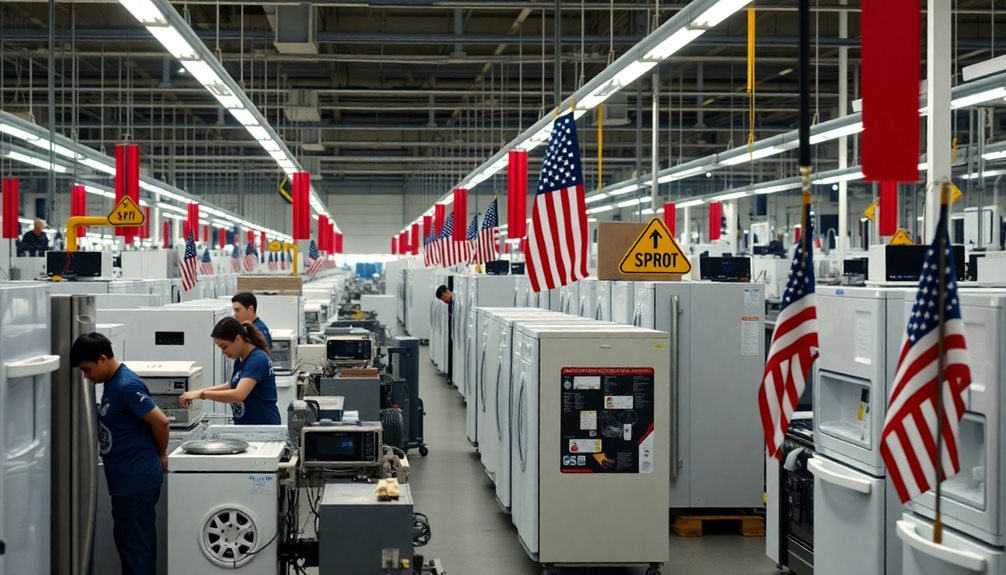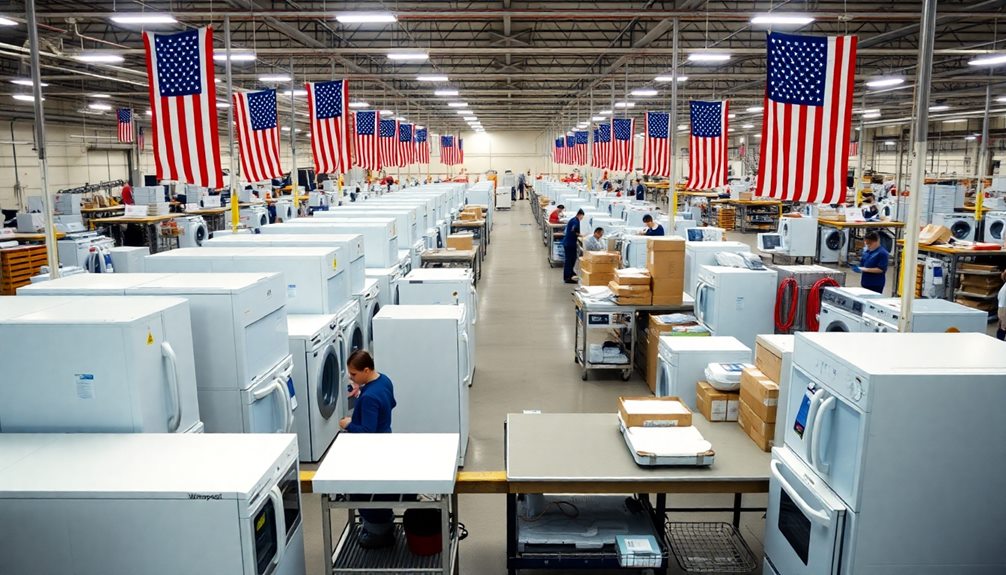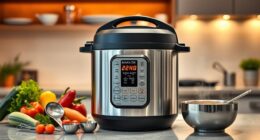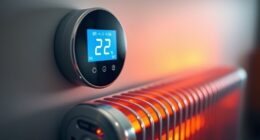Whirlpool appliances are primarily manufactured in the United States, with numerous production facilities located in states such as Tennessee and Ohio. It is important to acknowledge, however, that many components are sourced internationally, leading to a situation where claiming complete American-made status can be complicated. While a large portion of production takes place in the U.S., some products may contain foreign parts, which could come as a surprise to certain consumers. This blended sourcing strategy reflects the realities of modern manufacturing. For a more in-depth understanding of Whirlpool’s manufacturing processes and how they impact American industry, delving deeper into their approach could prove to be enlightening.
Key Takeaways
- Whirlpool products are primarily manufactured in the U.S., with major facilities in Tennessee, Ohio, Iowa, and Oklahoma.
- "Made in the USA" indicates significant domestic processing, but some components are sourced internationally.
- Many Whirlpool appliances, like the Cabrio and Vantage washers, are made in Ohio, yet contain foreign parts.
- Consumer Reports clarifies product labeling, helping buyers understand the difference between "Made in USA" and "Assembled in U.S.A."
- Whirlpool's commitment to domestic manufacturing is evident through a $1 billion investment to enhance U.S. production capabilities.
Overview of Whirlpool's Manufacturing

Whirlpool's commitment to American manufacturing is evident through its eight main facilities spread across Tennessee, Ohio, Iowa, and Oklahoma, where around 28,000 employees are dedicated to producing high-quality appliances.
This robust workforce underscores Whirlpool's significant role in the U.S. economy, especially as it holds over 35% of the market share in the washing machine sector. When you choose Whirlpool, you're opting for products in the USA that reflect a dedication to both craftsmanship and innovation.
Notably, Whirlpool's Cabrio and Vantage washers are manufactured in Ohio, while Maytag's top refrigerators come from Iowa. These products demonstrate the company's focus on maintaining a strong domestic presence.
Whirlpool has also launched a $1 billion initiative to expand its U.S. manufacturing capabilities, further solidifying its status as a leader in American manufacturing.
While some components may still be sourced from partner facilities overseas, the majority of Whirlpool's products are made right here in America.
This blend of local and international sourcing showcases Whirlpool's commitment to quality and efficiency, ensuring you receive reliable appliances that stand the test of time.
American-Made vs. Assembled

When choosing appliances, understanding the difference between "Made in America" and "Assembled in the U.S.A." is vital. The term "Made in the USA" means that a product has significant parts and processing originating in the U.S.
In contrast, products labeled as "Assembled in U.S.A." may incorporate imported parts, complicating your perception of American-made products.
For instance, while Whirlpool's Cabrio and Vantage washers are manufactured in Ohio, many brands, including Whirlpool, also produce appliances in overseas facilities. This mixed approach can muddle your understanding of what it means for a product to be truly American-made.
Additionally, companies like GE are investing heavily in domestic production, with a billion-dollar commitment to new U.S. product lines, signaling a potential shift in the manufacturing landscape.
Federal regulations are evolving, impacting how products are labeled and what qualifies as made in the USA, ultimately affecting your choices as a consumer.
As you navigate the appliance market, it's important to pay attention to these distinctions to make informed decisions that align with your values regarding American manufacturing.
Whirlpool Manufacturing Locations

Whirlpool has eight main manufacturing facilities across the U.S., including key cities like Cleveland and Tulsa.
These locations employ around 28,000 Americans, greatly impacting local economies.
While most appliances are made domestically, some products come from partner facilities abroad, adding complexity to their supply chain.
U.S. Manufacturing Facilities
Across the United States, Whirlpool operates eight major manufacturing facilities that play an essential role in its production process. These facilities are strategically located in key cities such as Cleveland, Findlay, Marion, Amana, Greenville, Ottawa, Tulsa, and Clyde.
Each manufacturing facility contributes to Whirlpool's commitment to producing quality appliances that are often labeled as Made in U.S.A.
With approximately 28,000 Americans employed across these manufacturing and operations sectors, Whirlpool showcases its dedication to American jobs. While you can find many of Whirlpool's products made domestically, it's crucial to acknowledge that some items are also produced in partner facilities overseas.
This blend of domestic and international manufacturing reflects the complex nature of modern production.
Although the precise percentage of products made internationally versus those manufactured in the U.S. isn't clearly defined, Whirlpool still emphasizes its American roots. By choosing to manufacture in the U.S., Whirlpool reinforces its commitment to quality and local employment, ensuring that many of its appliances continue to meet the high standards expected by American consumers.
Domestic Employment Impact
The impact of domestic employment in Whirlpool's manufacturing locations is significant and far-reaching. With eight main facilities across the USA, Whirlpool employs around 28,000 Americans, greatly contributing to job growth in local communities. As you consider the importance of domestic manufacturing, it's essential to recognize the key cities where this employment is centered.
| City | Employment Impact |
|---|---|
| Cleveland | Local job growth |
| Findlay | Community stability |
| Marion | Economic development |
| Amana | Skilled workforce |
| Tulsa | Regional support |
Whirlpool's commitment to American manufacturing plays an important role in the economy. While some appliances are produced overseas, the bulk of their products come from these domestic facilities. This blend of local and international production strategies highlights the company's dedication to maintaining a strong manufacturing presence in the U.S. By choosing Whirlpool appliances, you're not just selecting quality; you're also supporting countless American jobs and contributing to the strength of our economy. Every purchase has a ripple effect, impacting lives in your community and beyond.
Sourcing of Parts and Components

When you consider Whirlpool's appliances, it's crucial to understand the mix of domestic and imported parts involved in their production.
While many components are made in the U.S., some critical elements like electronics and motors come from international sources.
This blend raises questions about quality control and the true American-made status of their products.
Domestic vs. Imported Parts
Maneuvering the landscape of Whirlpool's sourcing practices reveals a complex interplay between domestic and imported parts. When you look closely, you'll notice that products labeled as "Made in America" require a significant portion of their components to originate from the U.S. In contrast, items marked "Assembled in U.S.A." might contain a mix of imported parts, which adds a layer of complexity to their manufacturing narrative.
Whirlpool employs around 28,000 individuals across eight manufacturing facilities in the U.S., including Tennessee, Ohio, and Iowa. Many of their products, like the Cabrio and Vantage washers, are crafted using both domestic and imported components. This reflects the realities of global supply chains that many manufacturers navigate today.
While Whirlpool has made substantial investments—like the $1 billion aimed at boosting domestic production—the truth is that a percentage of their products still rely on overseas sourcing. This highlights the ongoing challenge of achieving a 100% American-made status.
You can appreciate the effort Whirlpool puts into domestic manufacturing, but it's crucial to recognize the imported parts that play a role in their overall production.
Manufacturing Locations Overview
Understanding Whirlpool's manufacturing locations provides insight into how the company balances domestic production with global sourcing. Whirlpool operates eight main facilities across the United States, employing around 28,000 Americans. While many home appliances are made domestically, the company also collaborates with international partners for certain products.
Here's a quick overview of Whirlpool's U.S. manufacturing locations:
| Location | Key Products | Manufacturing Process |
|---|---|---|
| Tennessee | Cooking appliances | Mix of U.S. and imported components |
| Ohio | Cabrio & Vantage washers | Primarily U.S. sourced parts |
| Iowa | Maytag top refrigerators | Significant U.S. manufacturing |
Whirlpool's strategy includes a significant $1 billion investment to become the largest domestic refrigerator manufacturer. This move emphasizes their commitment to the "Made in America" ethos, although defining what that means can be complex. The manufacturing process combines both U.S. and imported materials, reflecting the intricacies involved in producing high-quality home appliances. As you consider Whirlpool's offerings, it's crucial to recognize this blend of domestic and international sourcing.
Quality Control Measures
While Whirlpool prioritizes quality in its manufacturing processes, the sourcing of parts and components plays a critical role in maintaining high standards. Regular cleaning and servicing can help improve appliance efficiency, as noted in effective preventive maintenance strategies.
You'll find that a significant portion of Whirlpool's components is imported, which raises questions about the overall quality control of their appliances. In their eight main manufacturing facilities across the U.S., including Tennessee, Ohio, Iowa, and Oklahoma, Whirlpool employs around 28,000 Americans. These locations focus on assembling products, but they still rely on imported parts for certain components.
Whirlpool is committed to increasing its domestic manufacturing capabilities, investing $1 billion in new product lines. This commitment is evident in models like the Cabrio and Vantage washers, which are fully assembled in Ohio.
However, it's important to recognize the distinction between "Made in America" and "Assembled in the U.S.A." Many of their products contain both U.S.-made and imported parts, reflecting the complexity of modern manufacturing.
Comparison With Other Brands

When comparing Whirlpool to other appliance brands, it's clear that Whirlpool dominates the U.S. washing machine market with over 35% of the share, far exceeding competitors like Samsung and LG.
While Samsung and LG have ramped up their U.S. production due to tariffs imposed in 2018, they still can't match Whirlpool's commitment to American-made manufacturing. Whirlpool operates eight manufacturing facilities in the U.S., ensuring a strong domestic presence and reinforcing its reputation for quality.
In contrast, brands like GE, Bosch, and Electrolux adopt a more diversified approach. Some of their products are made domestically, but many are produced overseas, which can affect their overall market share.
Significantly, Whirlpool's main competitor, Maytag, is also owned by Whirlpool, further solidifying its dominance in American manufacturing.
As consumer preferences lean towards American-made products, it's clear that Whirlpool is well-positioned to meet this demand.
Other brands are investing in U.S. facilities, but none have the same level of commitment or market share as Whirlpool. This dedication to domestic manufacturing not only sets Whirlpool apart but also reflects the evolving landscape of the appliance industry.
Consumer Perceptions and Myths

Many consumers mistakenly believe that all Whirlpool appliances are made entirely in the USA, which can lead to confusion about the brand's manufacturing practices. While Whirlpool does operate several manufacturing facilities in the U.S., some products contain parts sourced from foreign manufacturers. This mix complicates consumer perceptions about what "made in the USA" truly means.
Understanding where components come from is vital. Here's a clear breakdown:
| Label | Description | Implication |
|---|---|---|
| Made in U.S.A. | Assembled in the U.S. | May include foreign parts |
| Made in U.S.A. of U.S. and imported parts | Combination of domestic and foreign components | True American-made status is unclear |
| Assembled in U.S.A. | Final assembly in the U.S. | Not all parts sourced domestically |
| Fully Made in U.S.A. | Entirely sourced and produced in the U.S. | Clear American-made status |
Consumer Reports emphasizes these distinctions to help you make informed choices. It's important to recognize that the "Made in America" label might not always reflect the complete story regarding Whirlpool appliances.
Economic Impact of Manufacturing

The economic impact of Whirlpool's manufacturing operations extends far beyond the factory walls, considerably benefiting local communities and the national economy. With approximately 28,000 employees across eight main manufacturing plants in Tennessee, Ohio, Iowa, and Oklahoma, Whirlpool considerably contributes to local economies. This workforce not only supports families but also drives demand for local services and businesses.
Additionally, the stability provided by regular employment contributes to creating a retirement savings plan, ensuring that workers can prepare for their financial futures.
As the U.S. washing machine market has grown by 35% over the past five years, Whirlpool has captured over 35% of that market share, demonstrating robust demand for domestically produced home appliances. Government tariffs on imports from competitors like Samsung and LG aim to protect U.S. manufacturers, which helps maintain this economic impact, although it may lead to higher prices for consumers.
Whirlpool's commitment to investing $1 billion in new product lines reflects its dedication to strengthening domestic production capabilities. This investment fosters innovation and competitiveness within the home appliance sector.
As the consumer landscape shifts towards quality and affordability, Whirlpool's manufacturing plants are poised to adapt, ensuring that the economic benefits continue to flow within the communities they serve.
Future of Whirlpool in the U.S

Whirlpool's future in the U.S. looks promising as it continues to adapt and innovate in a rapidly changing market. With eight manufacturing facilities employing around 28,000 Americans, Whirlpool is committed to making quality products right here in the United States. The company is focusing on expanding its production capabilities and introducing new product lines, particularly in the refrigerator sector, to maintain its competitive edge.
However, Whirlpool faces challenges from competitors like Samsung and LG, who are also relocating production to the U.S. in response to market dynamics. To stay ahead, Whirlpool must embrace innovation and respond to shifting consumer preferences.
Here's a snapshot of Whirlpool's current standing:
| Category | Current Status | Future Focus |
|---|---|---|
| Manufacturing Facilities | 8 main locations | Expand production capabilities |
| U.S. Market Share | 35% in washing machines | Increase refrigerator market share |
| Employment | 28,000 Americans | Job retention and growth |
| Competition | Facing pressures | Innovation and adaptation |
| Product Development | New lines in progress | Focus on American-made products |
How to Identify American-Made Products

When shopping for appliances, it's vital to know how to identify American-made products, as this can help you support local manufacturing and guarantee quality craftsmanship.
Start by checking product labels for "Made in USA" indicators. These labels signify that significant parts and processing occurred in the U.S., meeting domestic manufacturing standards.
You can also research manufacturers' websites to find detailed information about their sourcing and production locations. Many brands might produce some components overseas, so it's important to dig deeper.
Identify trusted brands known for their commitment to American manufacturing, like Whirlpool, Maytag, and KitchenAid, which have multiple facilities located across the country.
Don't forget to consult retailers; many have dedicated sections showcasing American-made products, catering to your interest in supporting American jobs.
Finally, explore online marketplaces and local stores for used appliances, as they often carry older models manufactured in the U.S. before many production shifts occurred.
Frequently Asked Questions
Is Whirlpool 100% Made in America?
No, Whirlpool's products aren't 100% made in America. While they manufacture many appliances domestically, they also use parts sourced from other countries, reflecting the complexities of global supply chains and modern manufacturing practices.
Are Whirlpool Appliances Made in China?
When you think of Whirlpool appliances, picture a blend of American craftsmanship and global sourcing. Some products are indeed made in China, so it's wise to check specific models to know their origins.
Is There a Class Action Lawsuit Against Whirlpool Refrigerator?
Yes, there's a class action lawsuit against Whirlpool refrigerators, primarily concerning faulty ice makers and cooling failures. You should stay informed about the developments, as they may affect your warranty and product reliability.
What Is the Biggest Problem With Whirlpool Refrigerators?
The biggest problem with Whirlpool refrigerators is their reliability. You might face issues like compressor failures, inconsistent temperature control, or malfunctioning ice makers, all of which can lead to costly repairs and frustration.
Conclusion
In the bustling world of home appliances, Whirlpool stands at a crossroads of tradition and modernity. While some of their products proudly bear the "Made in the USA" label, others are merely assembled here, leaving consumers to navigate a maze of truths and myths. As you explore your options, keep your eyes peeled for that American flag—symbolizing quality and craftsmanship. In the end, knowing where your appliances come from empowers you to make informed choices for your home.










